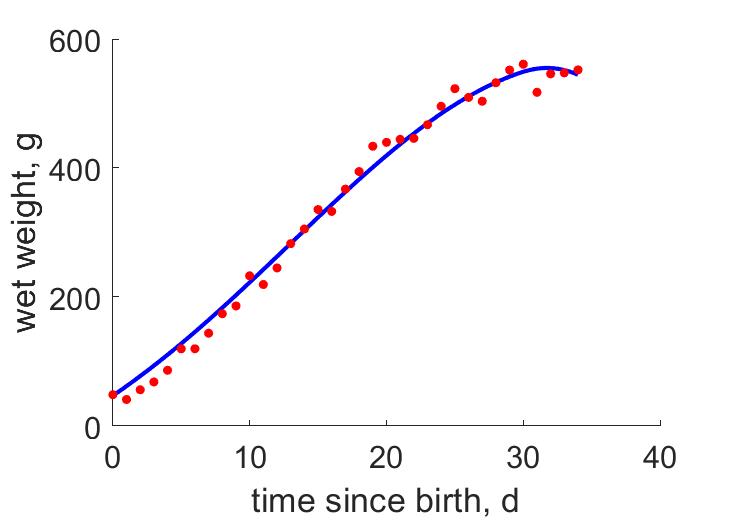Predictions & Data for this entry
| Model: std | climate: Cfa | migrate: Ml | phylum: |
| COMPLETE = 2.5 | ecozone: THp | food: biCvf, biCi, biSi, biSv | class: |
| MRE = 0.020 | habitat: 0iMm, biMc | gender: Dg | order: |
| SMSE = 0.001 | embryo: Tnsfm | reprod: O | family: |
Zero-variate data
| Data | Observed | Predicted | (RE) | Unit | Description | Reference |
|---|---|---|---|---|---|---|
| ab | 25 | 26.42 | (0.05699) | d | age at birth | avibase |
| tx | 30 | 30.05 | (0.001527) | d | time since birth at fledging | avibase |
| tp | 90 | 88.35 | (0.01837) | d | time since birth at puberty | guess |
| tR | 730 | 730 | ( 0) | d | time since birth at 1st brood | guess |
| am | 1.161e+04 | 1.152e+04 | (0.007538) | d | life span | AnAge |
| Ww0 | 66 | 66.32 | (0.004831) | g | initital wet weight | avibase |
| Wwb | 48.3 | 46.65 | (0.03415) | g | wet weight at birth | IsekWata2002 |
| Wwi | 522 | 535.3 | (0.02548) | g | ultimate wet weight for females | avibase |
| Wwim | 591 | 590.1 | (0.001463) | g | ultimate wet weight for males | avibase |
| Ri | 0.005479 | 0.00542 | (0.01092) | #/d | maximum reprod rate | IsekWata2002 |
Uni- and bivariate data
| Data | Figure | Independent variable | Dependent variable | (RE) | Reference |
|---|---|---|---|---|---|
| tW |  | time since birth | wet weight | (0.04011) | IsekWata2002 |
Pseudo-data at Tref = 20°C
| Data | Generalised animal | Larus crassirostris | Unit | Description |
|---|---|---|---|---|
| v | 0.02 | 0.0472 | cm/d | energy conductance |
| p_M | 18 | 503.4 | J/d.cm^3 | vol-spec som maint |
| k_J | 0.002 | 0.02054 | 1/d | maturity maint rate coefficient |
| k | 0.3 | 0.2989 | - | maintenance ratio |
| kap | 0.8 | 0.9512 | - | allocation fraction to soma |
| kap_G | 0.8 | 0.7997 | - | growth efficiency |
| kap_R | 0.95 | 0.95 | - | reproduction efficiency |
Discussion
- Feeding is slightly reduced towards end of nestling period
- Long tp cannot be captured by std model
- males are assumed to differ from females by {p_Am} only
- mod_1: v is reduced
- mod_2: Pseudo-data point k is used, rather than k_J; Data set tp and parameter t_R are added, the latter replacing clutch interval t_N. Postnatal T is based on PrinPres1991, see get_T_Aves. See further the revision page, theme puberty
Acknowledgment
- The creation of this entry was support by the Norwegian Science Council (NFR 255295)
Bibliography